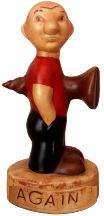 |
 The Virtual Corkscrew Museum's Weekly Newspaper |
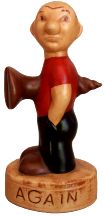 |
 |
 The Virtual Corkscrew Museum's Weekly Newspaper |
 |
|
Sunday, November 4, 2007 |
Number 486 |
Paris Art
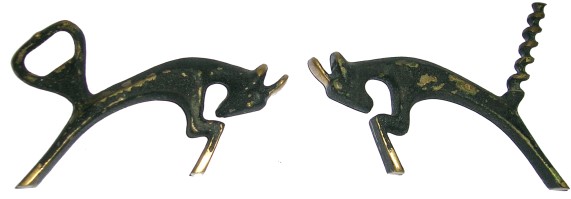
After reading about the Israeli corkscrews in the September 23 issue, reader Ian Hunter submitted photos of some similar corkscrews that he believes were made in Australia. Ian wrote "Like Israel, Australia had a lot of Jewish migration from Eastern Europe after WW2. I understand that in the 1950s a migrant from Vienna started making small ornaments in this style in Australia including corkscrews, ashtrays, ringholders, etc under the brand name 'Paris Art'. The items are often marked PARIS ART or PT and/or with a number, often 417. The cats and dogs in the photos, copies of Austrian or possibly Israeli corkscrews, are all marked in this way. I have also sent two kangaroos one of which, the one with the cap opener, is marked VIENNA ART. I have also sent a pair of deer which are unmarked and rather large - 4 inches from head to tail."
The corkscrews are all one piece blackened brass and have a cast worm. The worms are slightly different from the Israeli corkscrews - they have a flattened edge which is highlighted in brass.
Marked VIENNA ART
Corkscrew Inventor Arrested
Look what corkscrew inventor gets mentioned in The New York Times on April 7, 1910 (submitted by reader Mark Woodard):
Escapes Arrest by Suicide
Dr. Ladd was Accused of Causing Death of Harriet Lieberman
MOOSUP Conn., April 6 - Knowing that the Deputy Sheriff had a warrant for his arrest Dr. S. P. Ladd committed suicide at his home here late to-day by taking Prussic acid when he saw the officer drive up in front of the house and stop. Dr. Ladd was charged with causing the death of Harriet Lieberman, a young woman, who died in a New London hospital Sunday, and in connection with whose death Harry A. Chippendale of New London had been arrested earlier in the day.
Dr. Ladd was a graduate of the Harvard Medical School, was 62 years old, and leaves a wife and son.
Miss Lieberman was a ticket seller at a theatre in New London.
A query from Mark to Marcia Stuart at the New Haven library elicited this response:
"The only article that I found came from The Hartford Courant, May 18, 1910, which said that on this date Chippendale was found guilty of manslaughter and was sentenced to serve not less than three years and not more than six years in the state prison for manslaughter, this sentence to take effect after his uncompleted term for forgery. Chippendale claimed that he was just trying to help the woman who had the abortion. The judge said that Chippendale had just been paroled for forgery, was a married man, and the woman, before she died, had implicated Chippendale --all reasons for the sentence."
Mark supposed: "Since Chippendale's patent was applied for on Oct. 5, 1909 and he was granted his corkscrew patent on May 17, 1910, this would help to explain why his tool is marked Patent Applied For.
That is the Harry Chippendale who was granted U. S. Patent No. 958,092 on May 17, 1910 for his "Cigar-Cutter Forming Part of A Combination Tool". Harry applied for the patent on October 5, 1909 while a resident of New London, Connecticut.
A Painful Reminder
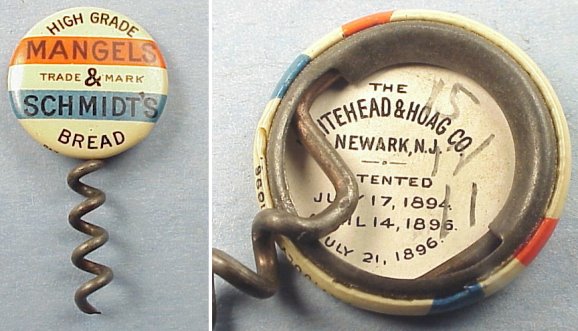
After reading about the Dr. Pierce corkscrew in the October 28 issue, reader Jack Bandy wrote:
"Do you remember? Do you remember trading this pinback for the Krueger Brewing corkscrew many, many years ago when you were here? The insert in the back of this one is primo, and shows 2 other related patents by George B. Adams in addition to the July 21, 1896 patent. I checked the other two patents, and the one on July 17, 1894 was for a 'Trousers-Strap', and the April 14, 1896 one was for 'Jewelry'. All three 'inventions' seem pretty closely related involving variations of ways to attach pins to badges, buttons, trousers straps, jewelry of all kinds, etc., etc. Adams also had numerous other patents dating from 1885 through about 1916. As for the Mangels & Schmidt's Bakery, they were in business in Newark, New Jersey. Wonder why, with all of Adams' inventiveness and ingenuity, he never patented the corkscrew variation itself, even as a design patent?"
And he added:
"The connection between the corkscrew idea and Dr. Pierce's patent medicine is pretty obvious. But, the use of a small corkscrew as an advertising gimmick by the Mangels & Schmidt bakery has always baffled me. I guess the logic must have been that their products were used in the kitchens, where, in those days, virtually every bottle was stoppered with a cork---so, why not?"
Gottfried Krueger Advertising Corkscrew
Mangels & Schmidt's Pinbacks by Whitehead & Hoag
Thomas Jefferson's Corkscrew
Reader Paul Luchsinger will be hosting the 2008 meeting of the International Correspondence of Corkscrew Addicts in Virginia. One of the events will be a visit to Thomas Jefferson's Monticello home in Charlottesville. Luchsinger is searching for any corkscrews that may have been owned or used by Jefferson. Also, he would like to find a drawing or painting of Jefferson using a corkscrew. Can anyone help?
On a recent visit to Monticello, Luchsinger stopped at the Visitor's Center where he found a Thomas Jefferson knife on loan from the Smithsonian Institute displayed. The knife had about eight tools including a wire helix and a hoof pick. Luchsinger wrote "Certainly he must have used a more stylish corkscrew when he was U. S. Ambassador to France from 1785-89 and traveled throughout France and Germany visiting wineries."
If you can help Paul, send him an email at paulcork@cox.net
Got one?
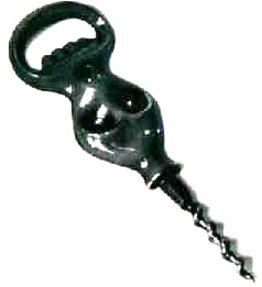
|
©2007 Don Bull, Editor |